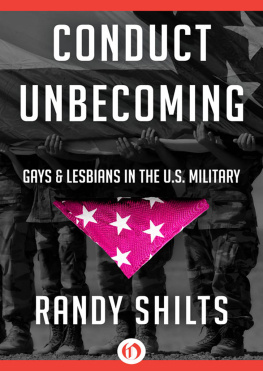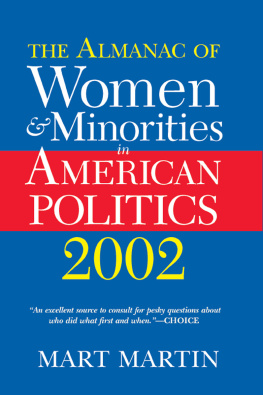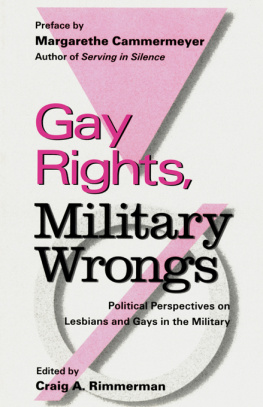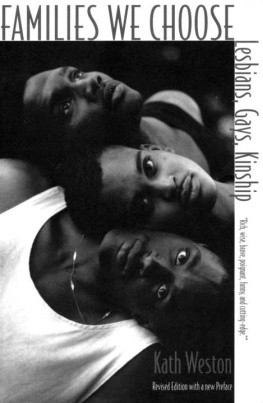Conduct Unbecoming
Gays & Lesbians in the U.S. Military
Randy Shilts

To Linda Alband,
a very good friend,
and of course to Barry Barbieri,
more than a friend
Contents
Truth is great and will prevail if left to herself.
Thomas Jefferson
Virginia Statute of Religious Freedom
P ROLOGUE
THE DANGEROUS DIFFERENCE
(17781954)
After a while youll think no thought the others do not think. Youll know no word the others cant say. And youll do things because the others do them. Youll feel the danger in any difference whatevera danger to the crowd of like-thinking, like-acting men. Once in a while there is a man who wont do what is demanded of him, and do you know what happens? The whole machine devotes itself coldly to the destruction of his difference. Theyll beat your spirit and your nerves, your body and your mind, with iron rods until the dangerous difference goes out of you. And if you cant finally give in, theyll vomit you up and leave you stinking outsideneither part of themselves, nor yet free. They only do it to protect themselves. A thing so triumphantly illogical, so beautifully senseless as an army cant allow a question to weaken it.
John Steinbeck
East of Eden
The Dangerous Difference
The history of homosexuality in the United States armed forces has been a struggle between two intransigent factsthe persistent presence of gays within the military and the equally persistent hostility toward them. All the drama and controversy surrounding the demand for acceptance by lesbians and gay men in uniform represents the culmination of this conflict, one that dates back to the founding of the Republic.
Over the past twenty years, as the gay community has taken form in cities across the nation, a vast gay subculture has emerged within the military, in every branch of the service, among both officers and enlisted. Today, gay soldiers jump with the 101st Airborne, wear the Green Beret of the Special Forces, and perform top-level jobs in the black world of covert operations. Gay Air Force personnel have staffed missile silos in North Dakota, flown the nuclear-armed bombers of the Strategic Air Command, and navigated Air Force One. Gay sailors dive with the Navy SEALS, tend the nuclear reactors on submarines, and teach at the Naval War College. A gay admiral commanded the fleet assigned to one of the highest-profile military operations of the past generation. The homosexual presence on aircraft carriers is so pervasive that social life on the huge ships for the past fifteen years has included gay newsletters and clandestine gay discos. Gay Marines guard the President in the White House honor guard and protect U.S. embassies around the world.
Gay military personnel are among the graduates of Annapolis, West Point, and the Air Force Academy in Colorado Springs. At least one gay man has served in the astronaut program. Recent gay general-staff officers have included one Army four-star general, renowned in military circles, who served as head of one of the most crucial military missions of the 1980s. In the past decade, gay people have served as generals in every branch of the armed forces. The Marine Corps has also had at least one gay person at four-star rank since 1981, and at least one gay man has served on the Joint Chiefs of Staff in that time.
Never before have gay people served so extensivelyand, in some cases, so openlyin the United States military. And rarely has the military moved so aggressively against homosexuality. The scope and sweep of gay dragnets in the past decade have been extraordinary. Their aim is to coerce service personnel into revealing names of other homosexuals. If investigators are successful, the probes turn into purges in which scores of people are drummed out within weeks. The pressure to cooperate is so fierce that lovers sometimes betray their partners and friends turn against one another.
Separation hearings and courts-martial follow the investigations. But finding witnesses for the defense can be a problem. In the recent purge of lesbians at the Parris Island Marine Corps Recruit Training Depot, two Marines who stepped forward as character witnesses for an accused lesbian were reduced in pay, demoted, and received negative job evaluations. Their superiors openly admitted the Marines testimony was the reason for the poor ratings. The accused lesbian was quickly dispatched to prison, and lawyers for later defendants found it very difficult to solicit character witnesses. An administrative board in a related case recommended a less than honorable discharge for a Marine captain because she had a civilian lesbian friend. In another case, a senior Navy officer was consistently passed over for promotion after testifying on behalf of an accused gay ensign. Though the ensign was his own son, in the Navy, fathers are expected to turn against their children if their children are accused of homosexuality.
The ruthlessness of the investigations and hearings serves a central purpose: to encourage lesbian and gay soldiers to resign from the military, to accept passively an administrative discharge or, if they are officers, to leave quietly under the vague rubric of conduct unbecoming. Such quiet separations help conceal the numbers of lesbians and gay men the military turns out of the service, as many as two thousand a year during the past decade.
In the past decade, the cost of investigations and the dollars spent replacing gay personnel easily amount to hundreds of millions. The human costs are incalculable. Careers are destroyed; lives are ruined. Under the pressure of a purge, and in the swell of rumors that often precedes one, despairing men and women sometimes commit suicide.
The militarys policies have had a sinister effect on the entire nation: Such policies make it known to everyone serving in the military that lesbians and gay men are dangerous to the well-being of other Americans; that they are undeserving of even the most basic civil rights. Such policies also create an ambience in which discrimination, harassment, and even violence against lesbians and gays is tolerated and to some degree encouraged. Especially for lesbians, the issues are far more complex than simple homophobia, because they also involve significant features of sex-based discrimination.
There are many men who never wanted women in their Army or their Navy in the first place, and the military regulations regarding homosexuality have been the way to keep them out for the past decade. Until proven otherwise, women in the military are often suspected of being lesbian. Why else, the logic goes, would they want to join a mans world? Many of these women take jobs that have traditionally been held by men. If they are successful, they are suspect for not being womanly enough; if they fail, they are harassed for not being man enough to do the job.
The way women can prove themselves to be nonlesbians is to have sex with men. Thus antigay regulations have encouraged sexual harassment of women. Those who will not acquiesce to a colleagues advances are routinely accused of being lesbian and are subject to discharge. Some women have allowed themselves to be raped by male officers, afraid that the alternative would be a charge of lesbianism. Those who do complain of sexual harassment often find themselves accused: Their commands are far more intrigued with investigating homosexuals than with investigating sexual harassment. Several investigations of suspected lesbians in the 1980s presaged waves of pregnancies on various installations, as women became pregnant in order to avoid suspicion that they were gay.








